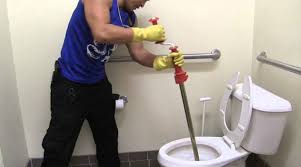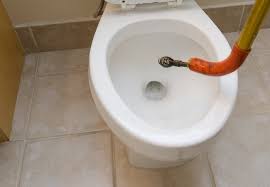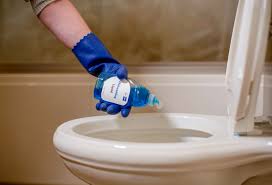How to Clear a Clogged Toilet With a Toilet Auger
To unclog a toilet, start with your easiest, least expensive options first.
First, try an accordion style toilet plunger.
- Accordion-style toilet plungers
- Look for a high-efficiency plunger that’s designed just for toilets, with a narrower, extended flange (that is, a round, lip-shaped reducer) at the bottom of the plunger to seal against the drain opening at the bottom of the toilet bowl.
- Before you begin, you may need to use a bucket to partially drain the toilet if the water level is close to the rim.
- Check to make sure the bottom of the plunger seals tightly against the opening at the bottom of the bowl.
- Use extra caution and wear fluid resistant gloves and eye protection when working on any plumbing fixture where chemical drain cleaners may have been used.

How to unclog a toilet with an auger
- Hold the handle grip with one hand and the crank with the other. Pull the crank up off the top of the handle until the cable as far up as it will go. The auger head “spring” at the end of the cable should be pressed up against the bottom of the handle.
- Lower the bowl guard or “bend” at the bottom of the handle into the toilet bowl. Gently insert it into the mouth of the drain, pointing in the same direction as the drain.
- Push the crank back down toward the top of the handle, until it comes to a stop or resistance.
- When you feel a stop or resistance, begin turning the crank in a circular clockwise motion as you continue to press down. Turn until the crank is sitting back on top of the handle—that means the cable is all the way through the length of the toilet pipe.
- If the cable gets stuck on the way down, try pulling up and cranking and then pushing down and cranking a few times. Don’t try to force the cable down or you could damage your toilet.
- Pull the crank back up straight off the handle to pull up any clogs or objects. If it gets stuck on the way up, crank the handle (still in a clockwise motion) as you pull up.
- You may need to try this a few times to dislodge the clog. You’ll know you’ve succeeded when the water in the toilet bowl goes down.
- When you think you’ve removed the clog, pull up the crank completely and remove the auger from the toilet. Try flushing (be ready to stop the flapper in the tank if the bowl fills up too much).
- Flush a few more times. If your toilet flushes normally each time, your clog has been successfully removed!
Before you put away your auger, make sure you wipe it down and remove any blockage debris from cable and the auger head “spring” at the end.

What to Do if the Plunger Doesn’t Work?
When a plunger is not enough to clear a clogged toilet, the next option is a toilet auger, (sometimes called a closet auger, named for an old term for toilet, the water closet). Like a standard drain snake, the toilet auger has a cable that rotates by a handle, but this tool is specially designed for toilets, with a hollow tube attached to an elbow fitting covered by a rubber sleeve that protects the toilet bowl from scratches.
It is certainly possible to clear a toilet clog with an ordinary drain snake, but all too often you will leave disfiguring scratches in the bottom of the bowl. A drain auger, on the other hand, will not scratch the porcelain of your toilet.
The flexible cable in a toilet auger is fed through the toilet drain using a hand crank, and the sturdy head of the cable is designed to dislodge tough clogs. This tool is not suitable for any other type of work, but considering that toilet clogs are by far the most common plumbing problem you will encounter, it is a tool worth owning.

Tips To Use A Toilet Auger
Clogged toilets are a nightmare, whether you’re dealing with a composting toilet or a regular water closet. It’s an eyesore, an embarrassment, and a potential health hazard. And it quickly escalates from a nasty smell to a toxic mess. Unfortunately, emergency plumbers are expensive!
Find The Source Of The Clog
There are two types of toilet clogs. The most common kind is restricted to the flushing toilet itself. It may be caused by toilet paper, or by an inappropriate item that fell (or was dropped) into the toilet. Kids’ toys, beauty products, and dirty washing water are common culprits. The second kind of clog happens in the sewer. For that type of blockage, you’ll have to call a professional plumber. You’ll know your sewer is blocked if there’s dirty water filling your sinks and tubs in addition to your toilet. If you have multiple clogs, you know it’s not just the toilet.
Remove Any Visible Debris
This doesn’t sound like fun at all, but it’s an essential step that many tutorials avoid. Wearing heavy-duty gloves, remove any messy matter and dump it in a bucket for disposal. Once this is done, pour a bucket of hot water into the toilet to see if it’ll dislodge any more dirt.
The reason you’re using a bucket instead of flushing the toilet is control. If you just flush it normally, the murky toilet water could flood your bathroom. With a bucket, you can pour a little at a time, observing the water level and preventing unhealthy spills.
Insert The Toilet Auger Or Plumbing Snake
This tool looks a little like a regular drain auger, but it has two protective casings made of rubber or plastic. Toilet augers have a ‘rubber elbow’ near the tip, and a hollow plastic or rubber tube in the middle. A coiled cable runs through the hollow tube casing, ending in a coiled hook.
It’s about 3 feet long when it’s fully stretched out, and has a spinning crank with a rotating handle. Place your auger into the toilet, pushing it in until the rubber elbow is nestled in the crook of your toilet. The rubber stops the wire from cracking your toilet surface.
That’s important, because cracks can cause leaks, and can eventually collapse the entire toilet bowl. They also form crevices where bacteria and toxic germs can hide. Once they’re in those gaps, it can be hard to get them out or clean the toilet properly, and this could lead to infections.
Plunger Alternative: Start With Dish Soap
As soon as the toilet clogs, learn how to unclog a toilet without a plunger and head to the kitchen and fetch some dish soap; the slippery soap should help lubricate the clogged pipe and allow the lodged debris slide down more easily. Pour about a half-cup into the toilet. If you haven’t got any dish soap on hand, chop a bar of soap into small chunks and drop the pieces into the toilet
Add Hot Water
If dish soap alone doesn’t do the trick for how to unclog a toilet without a plunger, adding water might move things along. Fill a bucket with hot bath water (boiling water could cause a porcelain toilet to crack), and pour the water into the toilet from waist level. The force of the water could dislodge whatever is causing the clog.
DIY a Drain Snake Using a Wire Hanger
A more severe blockage could require manually moving the item. To do this without a plunger, unravel a wire coat hanger until it’s straight. Push one end of the wire into the clogged area. Prod the debris until it becomes free and flows down the drain. Voila! Another way to unclog a toilet without a plunger.